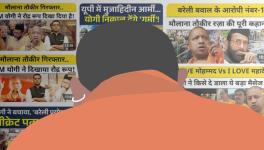Why Adityanath and Khattar Should Not Lecture Young Women
Speaking on Saturday at a public rally in Deoria, Uttar Pradesh Chief Minister Adityanath dusted off his old rhetoric against “love jihad” and promised to enact a law on the practice. On Sunday, Haryana Chief Minister Manohar Lal Khattar echoed him in Karnal.
Adityanath was the man who popularised the phrase “love jihad”, when he made it part of the Bharatiya Janata Party’s (BJP’s) lexicon in the middle part of this decade. Its salience as part of the party’s array of ideological weapons increased in 2017, when he made it one of the catchwords of his election campaign. He has since fulminated about this supposed practice on a regular basis.
For the uninitiated, “love jihad” is supposed to be a strategy consisting mainly of deceptions of various kinds used by Muslim men to entice Hindu women to run away with them, change their religion and then marry them. It seems to be suggested that it is a grand design to change India’s demographic profile. What committee of evil conspirators are directing this plot is not known.
Just for the record, the Centre had disavowed any knowledge of a thing called “love jihad” on 5 February this year. Union Minister of State for Home G Kishan Reddy had been categorical in the Lok Sabha that it was not defined in law and no cases had been reported by central agencies in connection with it, referring to Article 25 of the Constitution, which provides freedom to profess, practice and propagate religion subject to public order, morality and health.
On Saturday, however, Adityanath, repeated his unsubstantiated, fanciful charges of the existence of “love jihad”, which is in reality just another prong in his campaign of minority-baiting. And, as at other times, the language he used while talking of the proposed law was not that of a chief minister. “It’s a warning to those who exploit women by using false names and identities that they should stop doing this, otherwise their final journey will start,” he said. We shall return to this implicit suggestion of murder. But till we do, we may note that should he need further encouragement, it has been provided by the Akhil Bharatiya Akhara Parishad, which on Sunday demanded capital punishment in “love jihad” cases.
In Haryana, Khattar echoed Adityanath, but in somewhat more measured language. In the context of the killing of a Hindu girl in Ballabhgarh on 26 October by a Muslim would-be paramour, he said the issue was being looked at seriously and advice was being sought for drafting legislation that would prevent forced conversions.
Let us look at an important social index in the context of the two states—their sex ratios. Going by Census 2011, Haryana had 879 girls for every 1,000 boys and Uttar Pradesh 912. Among the states, Haryana took the last place at 29 and Uttar Pradesh was at 25. The reason is that both states have experienced a relentless campaign of gender-selective abortion that they have not been able to staunch. Haryana and western Uttar Pradesh, meanwhile have for decades been home to “honour killings”, directed by the medieval regime of khap panchayats, by which scores of young girls and boys trying to make their own matrimonial choices have been killed to satisfy patriarchal and obscurantist “codes” of “honour”. The less, thus, that Adityanath and Khattar lecture the public about their concern for young women in their states, the better it would distinctly be.
As media reportage and academic studies have shown abundantly, Haryana has for years been a destination for trafficked women from various (and usually poorer) parts of the country. Once they reach their destination, they are sold into marriage with men who cannot find women to marry. These marriages, as has been documented, involve various forms of bondage rather than conjugality. But compared to its neighbour, Uttar Pradesh, the state is in many ways a picnic.
Uttar Pradesh has over the past three years or so, since Adityanath ascended the chief minister’s chair, descended into a dystopian nightmare. Minorities are still in the process of being beaten into submission, while the conditions of Dalits have become even more precarious and marginal. But in the context of the love jihad garbage, the graph of crimes against women has skyrocketed. The rhetoric cannot hide the reality.
All this is happening because Adityanath and his government have given the police force in the state complete freedom to do whatever it wants. It is a force that is as ruthless as it is corrupt and incompetent. All of these qualities were grimly etched into the Vikas Dubey case in July, when the gangster killed eight police officers and was later arrested and killed himself. The impunity afforded to the police is clear from the fact that it has carried 6,145 encounters. More than hundred accused have been killed till July this year.
In this context, one must not omit mention of Adityanath’s other big idea—“anti-Romeo” squads. These were groups of three police officers sent out to places where young people hung out to check that youngsters were not doing what the chief minister did not approve. It soon became a vigilante movement that brought claustrophobia, harassment, and worse, into public spaces.
If Uttar Pradesh has descended into a kind of theatre of lawlessness, there are takeaways from which we can take heart. The chief minister’s threat to kill young people is one matter, but the possibility that he will actually be able to enact legislation connected to “love jihad” is not very high. First, the BJP government has actually brushed off the whole idea and pointed to the protections offered by Article 25.
Second, there is Article 21 of the Constitution as well. It says, “No person shall be deprived of his life or personal liberty except according to procedure adopted life.” In effect, as the Supreme Court ruled in August 2017, it lays the basis of the fundamental right to privacy of which the kind of law Adityanath is thinking of would be invasive.
It is, however, likely that Adityanath was just trying to be incendiary given that he was speaking at an election rally. He clearly aims both to keep his constituency condensed round him and put further pressure on the Muslim community. These two outcomes may unfortunately be achieved.
The author is a freelance journalist and researcher. The views are personal.
Get the latest reports & analysis with people's perspective on Protests, movements & deep analytical videos, discussions of the current affairs in your Telegram app. Subscribe to NewsClick's Telegram channel & get Real-Time updates on stories, as they get published on our website.
























